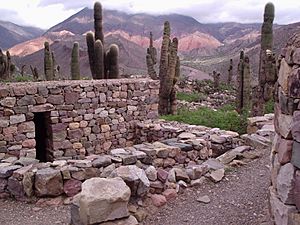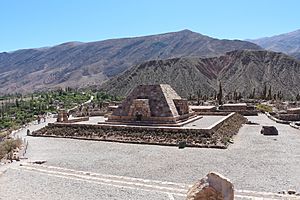Pucará de Tilcara facts for kids
The Pucará de Tilcara is an ancient stone fort built on a hill. It's located near the small town of Tilcara in the Argentine province of Jujuy. Imagine a 15-minute walk from town, and you're there! The people who built it chose this spot because it was easy to defend. It also offered amazing views of the long valley called the Quebrada de Humahuaca.
In 2000, the Pucará de Tilcara was named a National Monument. Parts of it have been carefully rebuilt. It's the only ancient site in the Quebrada de Humahuaca that you can visit today.
Contents
History of the Pucará
People have lived in this area for over 10,000 years! The fortified town itself was first built by the Omaguaca tribe. They settled here around the 12th century. The Omaguaca people were skilled farmers, weavers, and potters. They were also known as strong warriors. During their time, the pucará was a very important place. It served as a center for managing the area and for military activities.
At its busiest, the pucará covered about 15 acres (60,700 square meters). More than 2,000 people lived there. They lived in small, square stone buildings with low doors and no windows. Besides homes, the pucará had pens for animals, special places for religious ceremonies, and burial sites.
In the late 15th century, the powerful Incas conquered the tribes of the Quebrada. This happened under the leader Tupac Inca Yupanqui. The Incas used the pucará as a military base. They also used it to make sure they got metals like silver, zinc, and copper from nearby mines.
The Incas ruled the area for about 50 years. Their control ended when the Spanish arrived in 1536. The modern town of Tilcara was founded by the Spanish in 1586.
Exploring the Pucará Today
How the Pucará Was Found Again
In 1908, a scientist named Juan Bautista Ambrosetti from the University of Buenos Aires and his student Salvador Debenedetti rediscovered the site. They dug up and recorded over 3,000 ancient objects in just three years! Starting in 1911, they began to clear about 2,000 square meters (21,500 square feet) and rebuild some of the old structures. Later, in 1948, Eduardo Casanova took over the work. The site officially opened as an archaeological museum in 1966. Today, the University of Buenos Aires still manages the digging and rebuilding efforts.
The Pucará Museum
The museum at Pucará de Tilcara has ten rooms. Seven of these rooms show permanent collections. There are over 5,000 valuable historical items from different ancient Indian cultures. One very special item was a mummified body found in the Atacama Desert. It was in amazing condition, still fully clothed. However, this mummy is no longer on display.
- Room 1 shows items from Argentina and its neighbors, Chile and Bolivia.
- Room 2 focuses on the Indian cultures of Peru. You can see beautiful pottery from the Nazca, Mochica, and Chimú people.
- Room 3 displays objects from the time of the Spanish Conquest.
- Rooms 4 and 5 feature items from the Puna region and Jujuy. This includes a detailed reconstruction of an Aymara Indian burial ground.
- Room 6 is dedicated to pieces found right here at the Pucará de Tilcara fort.
- Room 7 shows more items from the wider Quebrada de Humahuaca valley.
Botanical Garden of Cacti
Next to the pucará, there's a small botanical garden. It's home to many different types of cactus plants that grow naturally in this area. It's a great place to see the unique plant life of the region.
There is a special plaque at the site. It explains that for a long time, people in Argentina thought most native groups disappeared after the Spanish arrived. This led to the idea that archaeology should "save" what was left of a "dead" culture. However, the voices of indigenous groups have shown this idea was wrong. In 1994, Argentina's National Constitution was changed. It now recognizes that Argentinian indigenous peoples existed culturally and ethnically before others. Today, archaeology helps keep the memory of these peoples alive.
See also
 In Spanish: Pucará de Tilcara para niños
In Spanish: Pucará de Tilcara para niños



